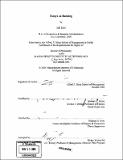Essays on banking
Author(s)
Erel, Isil
DownloadFull printable version (7.339Mb)
Other Contributors
Sloan School of Management.
Advisor
Stewart C. Myers and Stephen A. Ross.
Terms of use
Metadata
Show full item recordAbstract
This thesis consists of two chapters that investigate two important issues in banking of the past decade: the effect of banking consolidation on the borrowers and the regulatory capital requirements for banks. The first chapter analyzes the effect of bank mergers on loan prices, and the welfare implications for borrowers. In particular I test the hypothesis that mergers create efficiency gains which are, in fact, passed on to borrowers through a reduction in interest rates. The alternative hypothesis is that mergers lead to greater market concentration and in turn an increase in the cost of capital for borrowers. Using a proprietary loan-level data set for U.S. commercial banks, I find that acquiring banks, on average, reduce the spreads on their new commercial and industrial loans after a merger. The reduction in loan spreads is both larger and also more persistent for the smaller acquirers, with total gross assets less than $10 billion. These findings seem to be driven by cost efficiencies due to mergers, since the results are stronger for the sample of acquirers with larger than median declines in their operating costs after their mergers. Moreover, the reduction in spreads is much larger if the acquirer and the target have some geographical overlap of markets before the merger, and, consequently, more potential for cost savings. (cont.) However, if the market overlap is so extensive as to significantly increase market concentration, market power effects dominate and loan spreads, on average increase. The findings are robust to using variation in dates of intrastate banking deregulation as an exogenous instrument for the timing of the in-market mergers. Contrary to what might be expected, bigger acquirers do not impose less favorable pricing terms for small businesses seeking to borrow. Indeed, the reduction in spreads is significant for small loans, showing that small borrowers typically pay lower interest rates to banks that have expanded during the previous few years through mergers. The second chapter models the incentives of banks to undertake "Regulatory Capital Arbitrage" (RCA), under the current capital adequacy rules. RCA is a substitution of high-risk assets for low-risk assets with no requirement to increase their risk-based regulatory capital. I show that in equilibrium banks making risky investments pool with the banks investing safely so that they can be subject to a lower amount of regulatory capital because the risk exposures of banks cannot be precisely measured. The chapter examines whether the proposed "Basel II" regulatory system would be more or less efficient and effective than the current system. (cont.) Under the Basel II rules, banks will have an option to use their own internal risk assessment systems in determining their regulatory capital as long as they satisfy infrastructure requirements of the supervisors. I show that this Internal Ratings-based (IRB) Approach of Basel II can be interpreted as a way of forcing a separating equilibrium, in which good banks that do not pursue unduly risky strategies identify themselves to the regulators and are rewarded with a lower capital requirement. Such a separating equilibrium can only be sustained under an effective supervision system or by giving some incentives to the excessively risk-taking banks to stay in the current system rather than opting into the new IRB approach.
Description
Thesis (Ph. D.)--Massachusetts Institute of Technology, Sloan School of Management, February 2006. Includes bibliographical references.
Date issued
2006Department
Sloan School of ManagementPublisher
Massachusetts Institute of Technology
Keywords
Sloan School of Management.